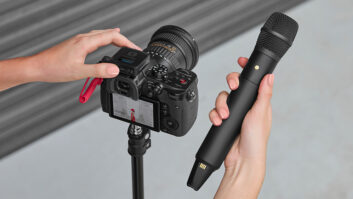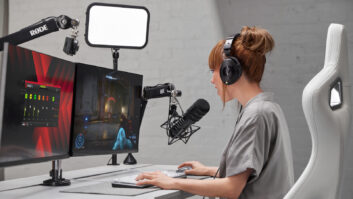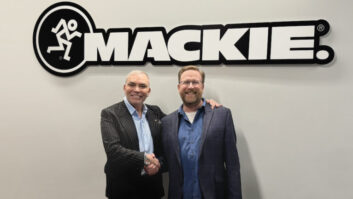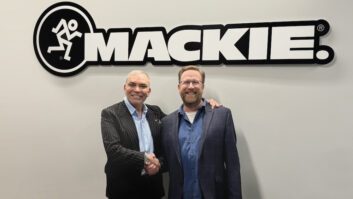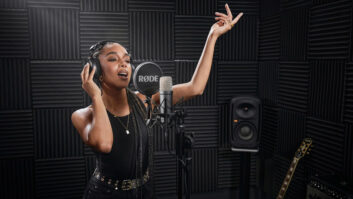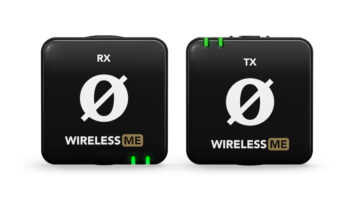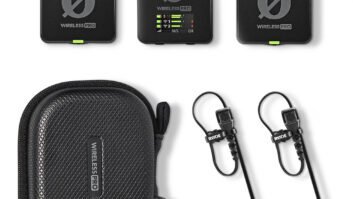More than 35 years ago, Henry and Astrid Freedman founded their
Australian-based Freedman Group of companies to design, manufacture and
install pro audio gear. The first products from the resulting Freedman
Electronics were loudspeakers, amplifiers and crossovers sold to the growing
Australian market. RØDE evolved from the company’s years of
experimentation and research into modifying existing microphones for
expanded bandwidth, smoother response and lower noise. In 1990,
RØDE’s first microphone, the NT2, debuted, and through the years,
the company has distinguished itself as a provider of high-quality
studio tools that are well outside of the “me-too” mold of
so many other microphones.
So when RØDE president Peter Freedman began working on the
company’s latest creation, he wanted to do something completely
different, and the NT2000 is the result of that quest. To give the
barest of descriptions, the NT2000 is a solid-state, multipattern,
large-diaphragm studio condenser mic. But besides its pristine 7dBA EIN
spec and clear, smooth sound, what sets the NT2000 apart from the rest
is the versatility of its “Totally Variable” controls. Set
into the mic body are continuous pots for setting polar pattern (from omni through cardioid to figure-8 and
anything in between); a 20 to 150 Hz tunable highpass filter; and a
(also variable) 0 to 10dB pad. The pattern-selector pot has a center
detent for the 12 o’clock cardioid position.
The NT2000 is a side-address design, with the control pots facing
the sound source. Under the large, multilayer windscreen is the HF-1, a
true (externally polarized) condenser capsule with dual-1-inch
diameter, 5-micron-thick Mylar diaphragms that are gold-sputtered and
then hand-tensioned and aged before clean room assembly at the
RØDE factory.
Under the nickel-finished, heavy brass body is a modern,
double-sided board with low-noise FET electronics in a combination of
axial and surface-mount components. The fit and finish are impeccable
throughout. The NT2000 has a most distinctive look, and bucking the
trend of the ever-growing logos on gear with the company name only on
the dark band at the base of the mic. The only obvious
RØDE-looking touch is the trademark circular brass insert that
marks the “front” of the cardioid direction on all of the
company’s side-address studio mics.
IN THE STUDIO
Once the box arrived—with its familiar logo and Sydney, Australia
return address—I was anxious to get started. The NT2000’s $899
retail price includes a molded, padded protective case that houses the
mic and shockmount. Speaking of the latter, the shockmount is made of a
tough, polymer material, with threaded metal insets for the stand-mount
and angle-adjustment screw. One nice touch: A long handle with a
release button really ensures the mic angle is solidly locked.
The 6-inch diameter shockmount is fairly sizable, which could make
some placements difficult, should you want to use the NT2000 in a
cramped space such as on a snare or in a complex percussion setup.
However, most applications for the NT2000 don’t involve such obstacles.
The shockmount is highly effective and required, as the mic is highly
sensitive and susceptible to handling noise. The mic itself is cradled
within the shockmount by an inner basket supported by thick elastic
cords that keep the mic aligned, yet provide ample protection from
vibrations, thonks and bonks that could transmit nasty low-end
rumble.
The mic is no lightweight: The NT2000 and shockmount tip the scales
at a hefty 2.33 pounds, so make sure that your mic stands are sturdy,
particularly when using booms.
My first session was recording a 4-string Appalachian dulcimer using
the cardioid setting, about 2.5 feet above and in front of the
instrument. The dulcimer’s bridge end has a brighter tone, so I turned
the pattern control a bit toward omni, which resulted in a nice, wide
cardioid that wasn’t entirely focused on the center of the instrument.
It provided a tone that was rich with upper-end harmonics and a full
bass from the drone strings. One thing that was evident was the
NT2000’s noise—or lack thereof—especially when using a
clean Millennia Media HV-3 preamp.
On a later (but unrelated) session, I tried to make an uncooperative
cat meow on cue for the mic, which was fruitless. When I decided to
give up, the cat finally walked away, stopped about five feet back and
gave a couple (far-field) meows. Fortunately, tape—er,
disk—was still rolling at that time, and because I had an
ultraclean audio path, I could just boost gain later and get a usable
take.
Cutting (human) vocals was a lot more fun. Recording some
doo-wop-style a cappella tracks, I decided to go the old way: one
singer on either side of the figure-8 pattern. A few things became
evident: The figure-8 pattern is consistent on both sides
and—like the cardioid setting—exhibits a wonderful proximity effect, adding
a nice bottom-end richness to the sound, without being overbearing.
Switching to cardioid for some close-in solo vocals, I had to use a
stocking pop filter to eliminate popping “p” and
“b” sounds. In cardioid, the NT2000’s wide, fairly flat
response doesn’t roll-off until about 14 kHz or so, and doesn’t exhibit
the huge presence peaks common to many other condensers. The mic has a
smoothness that’s more reminiscent of a C-12 than a C414, with a round,
full bottom and an unexaggerated top that worked well for male and
female vocals. On certain male singers—particularly
basses—you might want to add a hint of EQ for punch and clarity,
but this is hardly the mic’s fault.
Combined with the mic’s low-noise performance, the omni position was
great for distance room-miking—whether on piano or rock guitar
amping. Even when I used the NT2000 close in on loud amps, I never
needed the pad, as the mic handles high-SPL sources without a
hitch.
The continuously variable 20 to 150Hz roll-off is a gem. At the
halfway position, the mic was perfect for close radio-style narration
without a pop screen. The full-on 150Hz setting is more useful as an
effect, such as a “your table’s ready”-style narration, or
for rolling off low frequencies when recording drum overheads. I only
had one mic to test, so I didn’t track any drums, although I switched
the HP filter out and put the NT2000 over my studio kit, where its wide
bandwidth and excellent off-axis response offered a natural sound on
the entire kit with tons of detail.
At $899 retail (and a lower street price), the NT2000 has all of the
makings of a classic, with its sweet sound and versatility to handle
just about anything. Here’s a top choice for your mic locker.
RØDE Microphones, www.rodemic.com
BIG CHANGES DOWN UNDER
Five years ago, RØDE built a 20,000-square-foot mic factory on the
outskirts of Sydney, but there was a problem: With the company’s
growth, it soon needed a larger operation. Last month, RØDE began
moving into a totally new 70,000-square-foot plant. Located in
Silverwater, barely a stone’s throw from Sydney’s Olympic complex, the
new factory houses the company’s operations except metalwork for
bodies, which is handled by a facility in Aussie’s famed Blue
Mountains. The Silverwater complex offers state-of-the-art assembly
with surface-mount systems, clean rooms for capsule assembly, CAD
design and special listening rooms where each mic is evaluated before
shipping.

